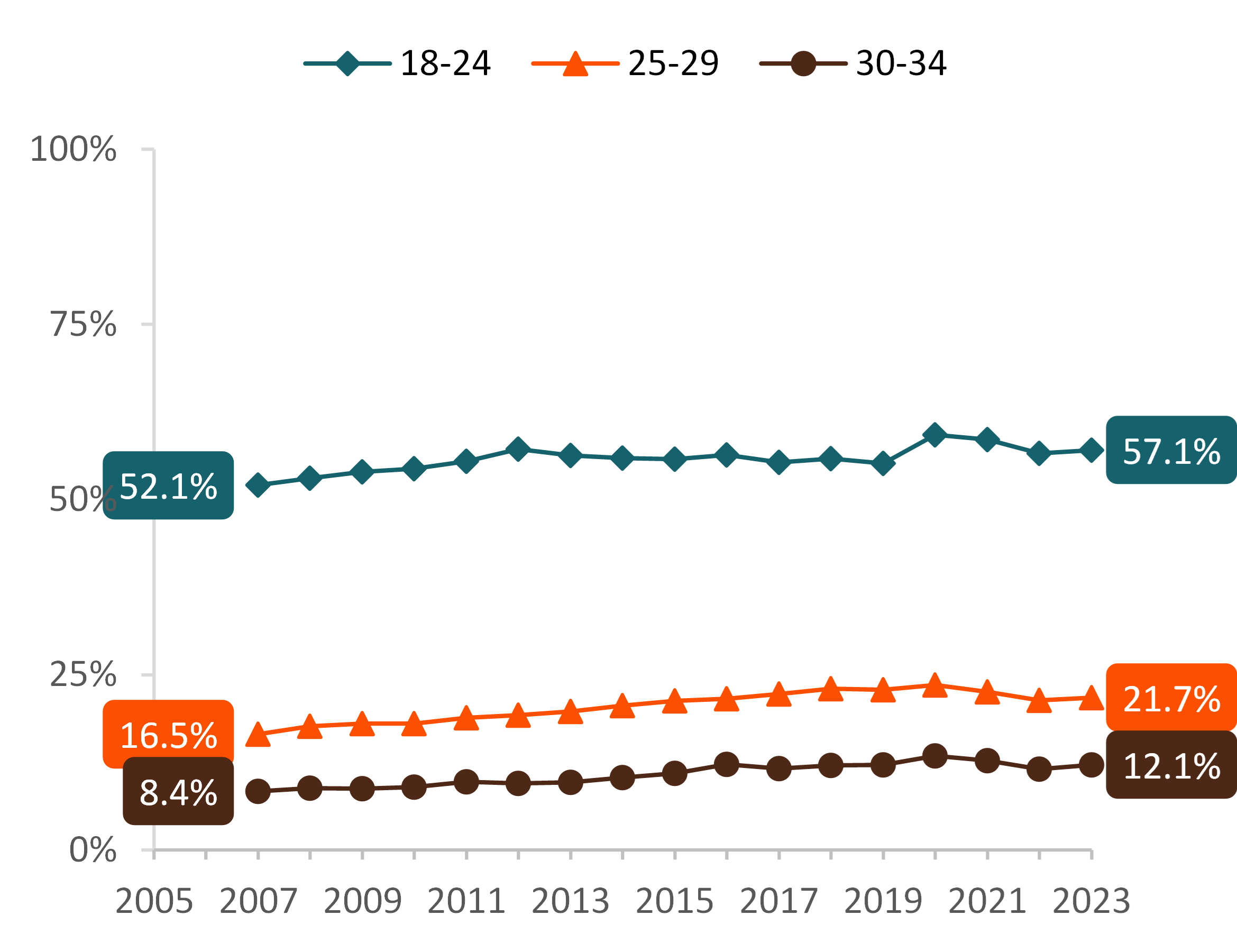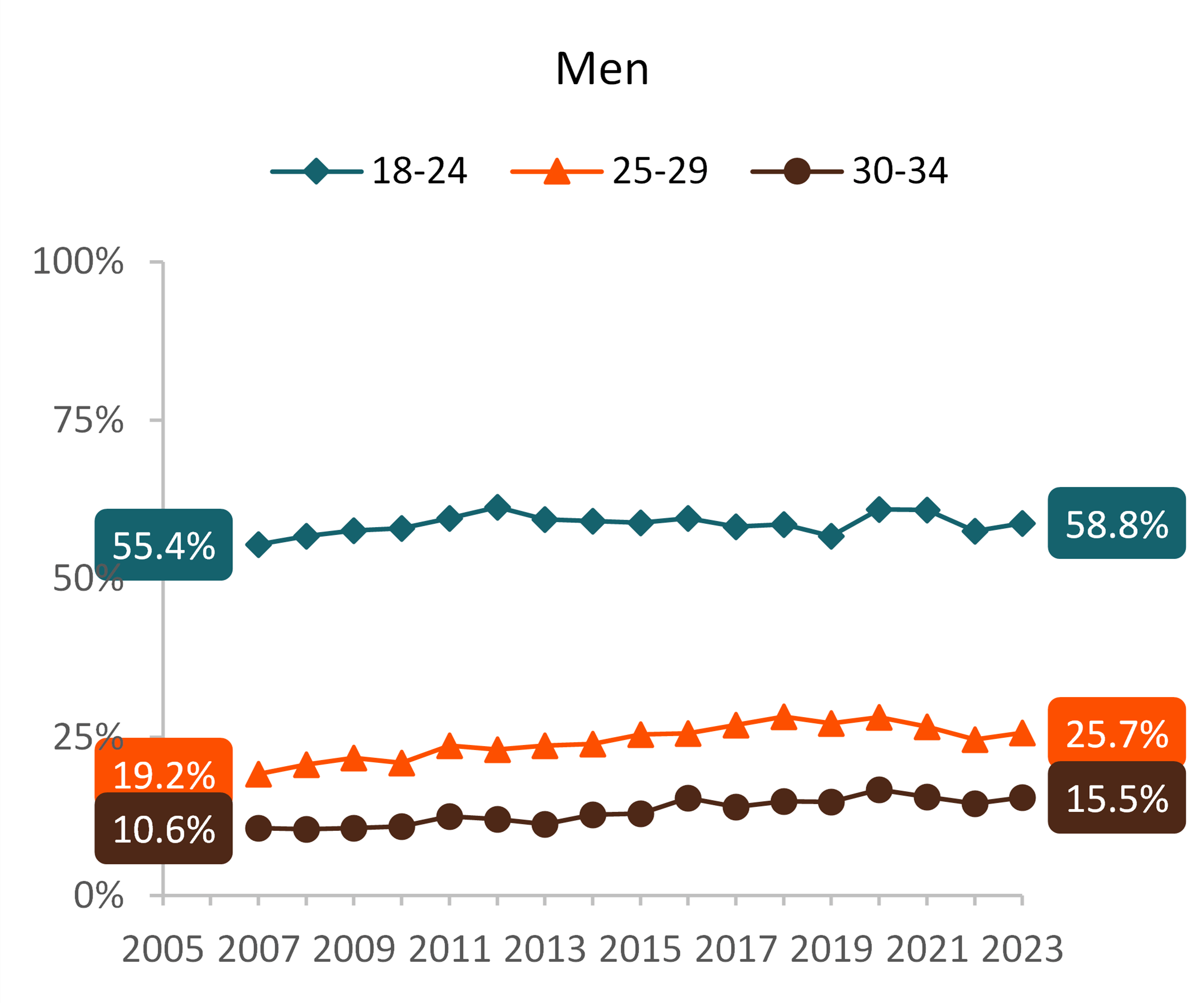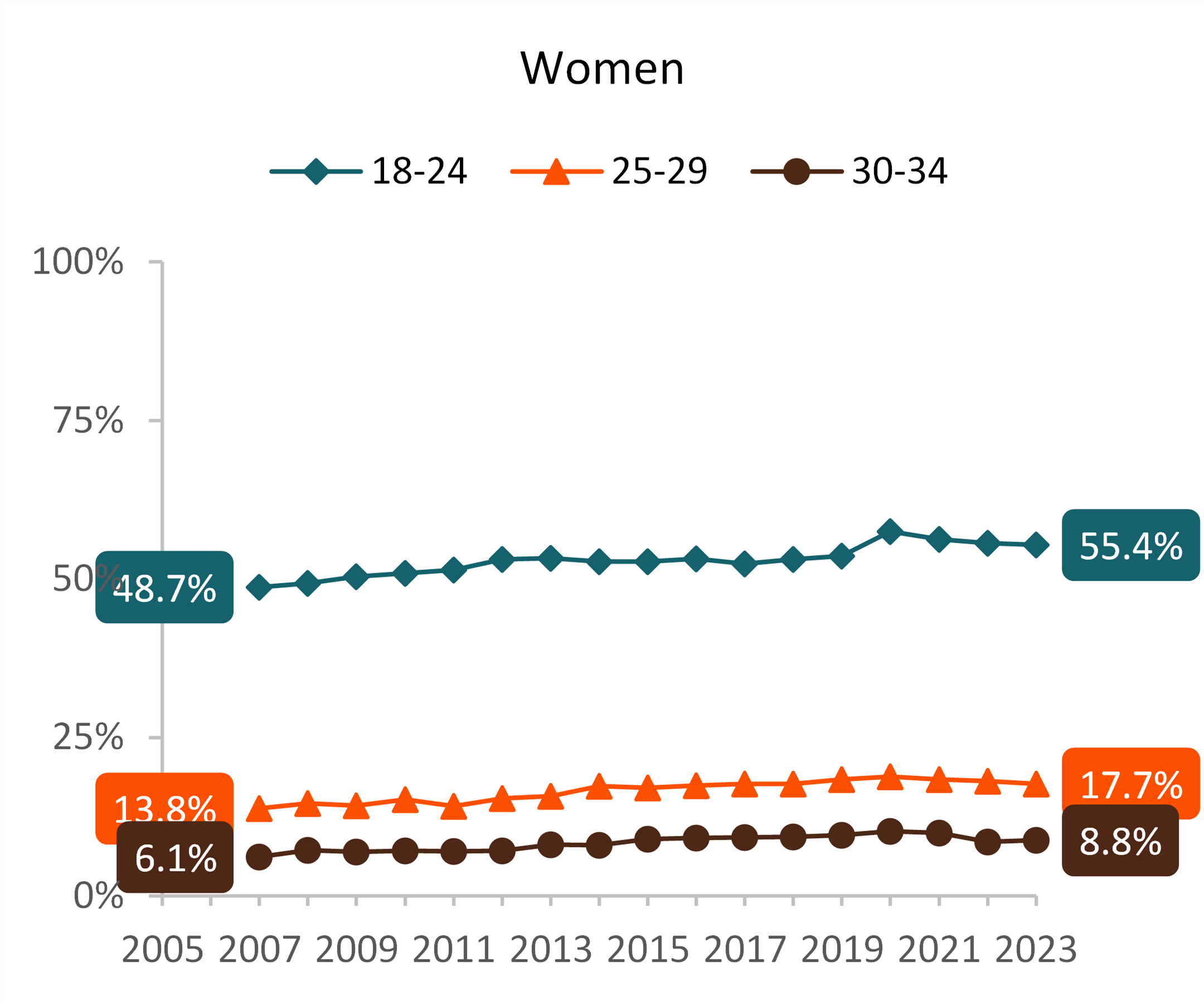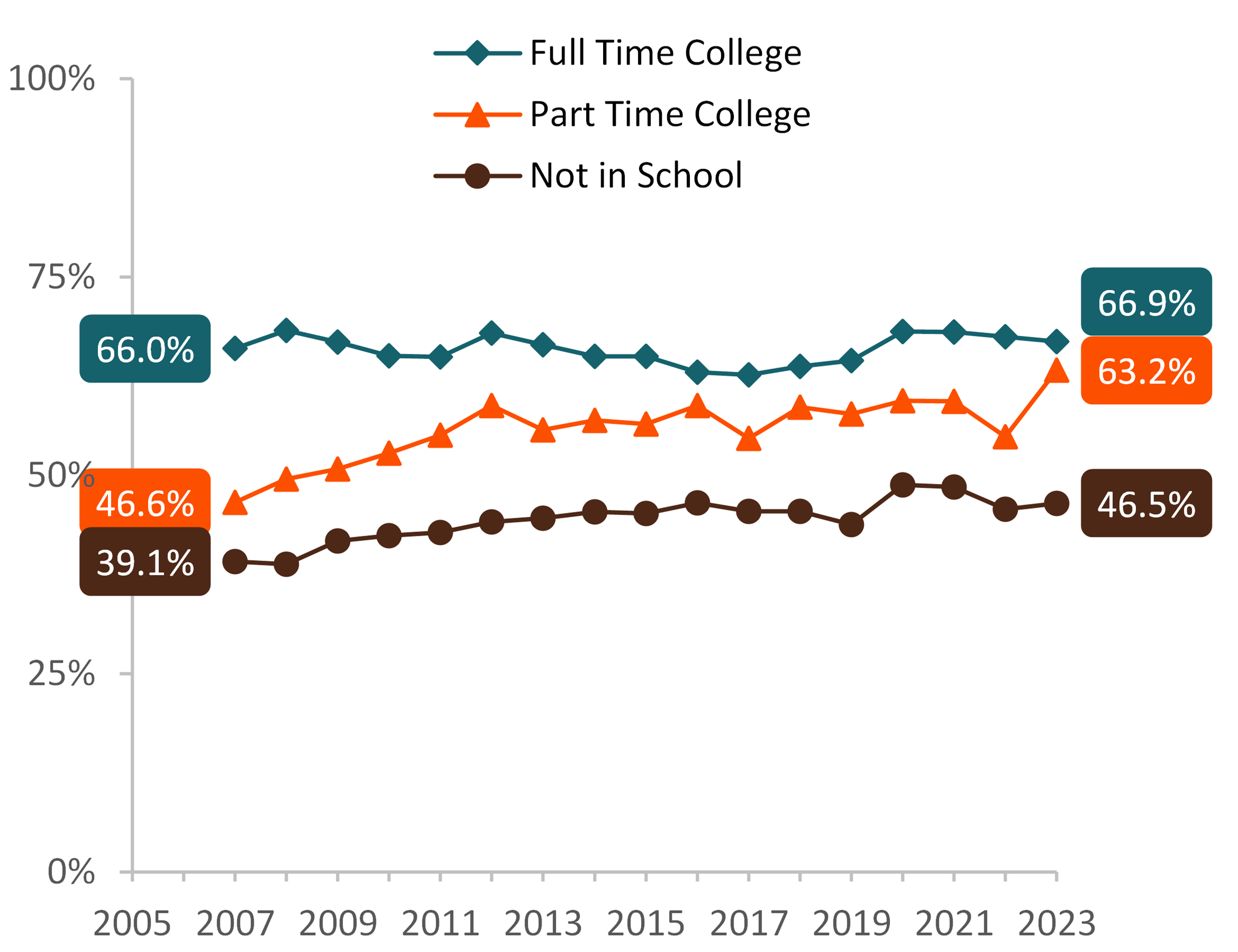Young Adults in the Parental Home, 2007-2023
This Family Profile is an update of:
FP-21-23
Family Profile No. 2, 2024
Authors: Jaden Loo
Young adults may choose to live with their parents for a variety of reasons, including finances (Sandberg-Thoma et al., 2015) and social support (South & Lei, 2015). Patterns of co-residence vary by young adult age, gender, and school enrollment. Using the Current Population Survey (CPS), we track young adults’ parental co-residence by age, gender, and school enrollment from 2007 through 2023 to shed light on how residential patterns of young adults have evolved three years into the COVID-19 pandemic. We define parental co-residence as living with one’s own parent(s) or a partner/spouse’s parent(s). This family profile updates previous profiles on parental co-residence using recent data (FP-21-23, FP-19-04, FP-16-16, FP-13-07, and FP-12-22).
Share of Young Adults Living in the Parental Home by Age Group
Between 2007 and 2023, the share of young adults co-residing with parents increased across all age groups and peaked in 2020 for all age groups considered here. However, the prevalence of parental co-residence varied by age group.
- Across the last 16 years over half of those in the youngest age group (18-24) lived with their parents and had the largest share living in a parent’s home.
- The portion of 18-24 year olds living with parents peaked in 2020 at 59.2%. The share has slightly dropped and in 2023 the estimate ticked up slightly to 57.1%.
- In 2023, more than one in five (21.7%) young adults aged 25-29 were living in the parental home, up from 16.5% in 2007.
- The share of young adults co-residing with parents in the oldest age group, 30-34, has gradually risen from 8.4% in 2007 peaking at 12.8% in 2020. In 2023 the share of 30-34 year olds who lived with parents dropped slightly to 12.1%.

Between 2007 and 2023, the share of young adults co-residing with parents increased across all age groups and peaked in 2020.
Share of Young Adults Living in the Parental Home by Sex and Age Group
- Estimates of young adults co-residing with a parent has gradually increased across all age groups from 2007 to 2023, regardless of sex.
- The share of young adults co-residing with a parent was highest among those at younger ages.
- In 2023, 58.8% of 18-24 year old men and 55.4% of 18-24 year old women were living in a parent’s home compared to 15.5% of 30-34 year old men and 8.8% of 30-34 year old women.
- Parental co-residence peaked for women across all three age groups in 2020. For men, those aged 18-24 and 30-34 experienced their peak co-residence estimates in 2020.
- Across all age groups for both men and women, co-residence estimates in 2023 were lower than those in 2020.
- Parental co-residence was higher for young adult men than women cross all age groups.
- In 2023, the largest difference between men and women was among those aged 25-29 (25.7% vs. 17.7%, respectively).
Figure 2. Share of Young Adults Living in the Parental Home by Age Group for Men and Women, 2007-2023


Source: NCFMR analyses of IPUMS-CPS, Current Population Survey, ASEC, 2007-2023
Share of Young Adults Aged 18-24 Living in the Parental Home by College Enrollment
- A greater share of young adults aged 18-24 enrolled in college full-time co-resided with parents compared to those enrolled part time or not enrolled.
- All three enrollment groups saw increases in their co-residing shares in 2023 compared to 2007.
- The largest increase between any two time points was observed among those enrolled part time from 2022 into 2023, when their co-residing share increased from 54.8% to 63.2%.
- This pattern represents convergence in the share coresiding with a parent between those enrolled part time and full time (63.2% and 66.9%, respectively).
- Parental co-residence among those not enrolled in school increased from 39.1% in 2007 to 46.5% in 2023. This most recent estimate is slightly lower than the 48.8% peak during the first year of the pandemic (2020).
Figure 3. Share of Young Adults Living in the Parental Home by College Enrollment, 2007-2023

Data Source:
Flood, S., King, M., Rodgers, R., Ruggles, S., Warren, J. R., Warren, D., Chen, A., Cooper, G., Richards, S., Schouweiler, M., & Westberry, M. (2023). IPUMS, current population survey: Version 11. 0 (11.0) Current Population Survey. Minneapolis, MN: IPUMS. https://doi.org/10.18128/D030.V11.0
References:
Sandberg‐Thoma, S. E., Snyder, A. R., & Jang, B. J. (2015). Exiting and returning to the parental home for boomerang kids. Journal of Marriage and Family, 77(3), 806–818. https://doi.org/10.1111/jomf.12183
South, S. J., & Lei, L. (2015). Failures-to-launch and boomerang kids: Contemporary determinants of leaving and returning to the parental home. Social Forces, 94(2), 863–890. https://doi.org/10.1093/sf/sov064
Suggested Citation:
Loo, J. (2024). Young adults in the parental home, 2007-2023. Family Profiles, FP-24-02. Bowling Green, OH: National Center for Family & Marriage Research. https://doi.org/10.25035/ncfmr/fp-24-02
This project is supported with assistance from Bowling Green State University. From 2007 to 2013, support was also provided by the U.S. Department of Health and Human Services, Office of the Assistant Secretary for Planning and Evaluation. The opinions and conclusions expressed herein are solely those of the author(s) and should not be construed as representing the opinions or policy of any agency of the state or federal government.
Updated: 04/30/2024 02:47PM

